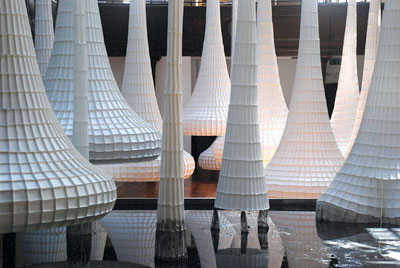

'Elephant Bed' (Brighton), 2009, Corn-based polymer, biodegradable methyl cellulose skins
20 forms, 24' x 6' x 6' each
Photo: the artist, Photo of the artist at work in studio: Maria Grade
On April 10, 2010, Seattle artist John Grade’s installation at the Whatcom Museum in Washington State—comprised of ten, 24-foot high hanging sculptures made of degradable polymer materials, titled Bloom: The Elephant Bed—will end. Those pieces which have not slowly disappeared into a large pool of ink during the course of the exhibit will be walked into Bellingham Bay, where they will be left to dissolve in its waters, reprising a similar Elephant Bed ritual last year in England. This summer, Grade’s enormous, bog-inspired Seeps of Winter, which exhibited at Seattle's Suyama Space in 2008, will be erected on a glacier in the central Cascades, and his woodwork Fold will be buried in the desert to become infested with termites. Both these latter works will later be retrieved, in their resultant eroded condition.
Grade (pronounced Grah-day) is a 39-year-old sculptor who has turned the original notion of environmental art on its head. Grade's art is a departure from the radical earthwork anti-aesthetic of forty years ago. He has established a new paradigm for art directly engaging nature, which he describes as “a human approach to environmental art that is not political in any way.” His sculptures’ time in the wild is temporary: they are often transported to disparate climates in a labor-intensive itinerary that entails substantial transformative exposure to the elements, before moving on to indoor venues, or vice-versa. It is sculpture realized through landscape, in collaboration with it rather than imposed upon it, and as such it is profoundly ecological. Two projects, Collector (2007) and Host (2008), were premised on the notion of contributing to the environment in the course of their decomposition. His art embodies an open-endedness and fluidity that replicates nature itself.
Inspired by both biological and anthropological sources, Grade’s work displays a sensitivity to the subtleties of organic architecture, which provides the formal framework for his themes of decay, regeneration, and other organic processes. From its earliest incarnations, Grade’s approach to sculpture was intrinsically unconventional, in his use of both industrial and organic non-art substances, and in its vague figurative or functional associations; his biomorphic forms seemed to exude a sense of suspended animation, of life forms in flux. After 2004, a significant shift in scale took place in his art. Grade explains it as wanting to eliminate “the level of remove between the viewer and the work… rather than having them just read the work, I want them to live it. There was also a tidiness to the process that felt staid.” The messiness of the physical natural world beckoned.
A critical impetus to this new phase of Grade’s art was his time spent at various residencies in this country and abroad, like the Ballinglen Arts Foundation in Ireland where the peat bogs of County Mayo inspired Seeps of Winter. For Grade these long retreats were “incubators” of new ideas and his expanding artistic vision. The collaborative atmosphere was also inspiring, and his conversations with composers and writers “helped me to think about my sculpture not as static objects with an intended ideal state to preserve, but as stories or compositions with an arc, with life…” Grade’s insistence on an ecological and human social component in his creative projects is an outgrowth of this collaborative spirit.
Grade’s willingness to relinquish control of his art is also integral to the transition from sculptural objects to projects: 'The complicated dynamic of organizing people's contributions, and all the unknown in the outdoor sites and travel from exhibition to sites and back, the way anticipation of external forces--erosion, insects, birds, degradation of materials--becomes a factor in structuring the work.' The multiple lives of these installations are a reflection of the integrating and fleeting elements that shaped them.
John Grade's work 'Bloom: The Elephant Bed' at the Whatcom Museum in Bellingham, WA will be up until April 10, 2010. On May 12, 2010, a new sculpture entitled 'Circuit' will open at the Cynthia Reeves Gallery in New York City. Before being buried this summer in the Utah desert, 'Fold' will exhibit at the American Academy of Arts and Letters in New York from March 7 to April 15, 2010. Grade is represented commercially by Davidson Galleries in Seattle.
